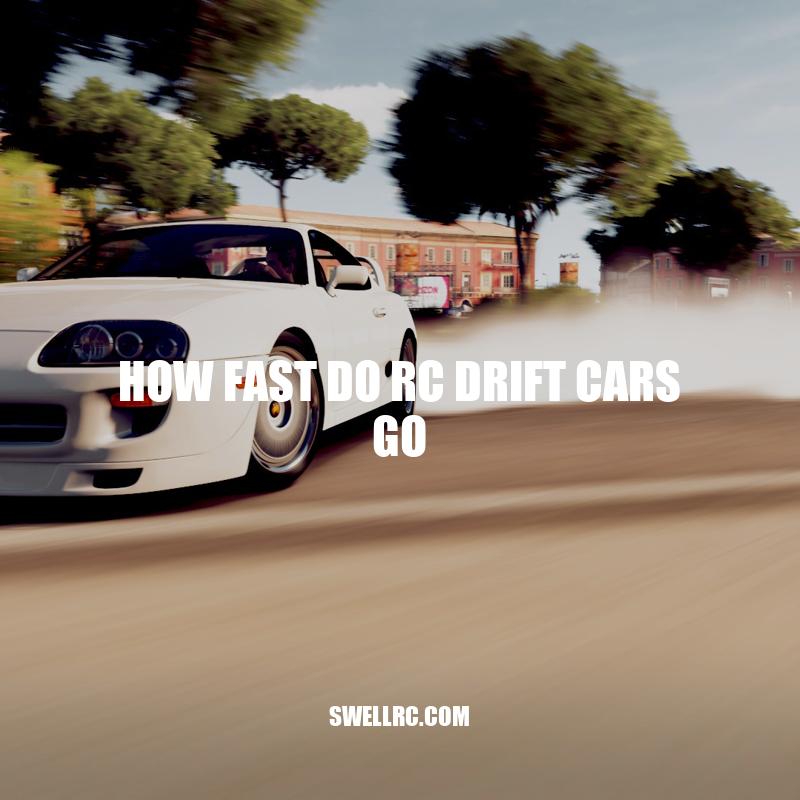How Fast Do RC Drift Cars Go: Exploring Speed Limits and Factors
RC drift cars are remote-controlled vehicles that mimic the movements of actual drift cars. Their popularity surged in Japan and is gaining momentum across the globe. Unlike other RC cars, RC drift cars are not designed to be quick and efficient at a straight line. They are built with drifting maneuvers in mind, which enhance the drift experience. RC drift racing has become a sport with a massive following, and enthusiasts invest a significant amount of time, effort, and money just to get to the podium. But how fast can these drift cars go? In this article, we’ll take a closer look at RC drift car speed, what affects it, and why enthusiasts still choose these cars despite their inability to reach high speeds.
RC Drift Car Speed Limits
RC drift cars have a lower maximum speed compared to other types of RC vehicles. The maximum speed of an RC drift car is typically between 20-25 mph. The speed limit is brought about by various factors, including:
- The motor’s power output
- The weight of the car
- The tire grip and wheel design of the car
Compared to other RC cars, the wheels on an RC drift car are designed to slip and slide, reducing their traction and speed potential. RC drift cars are built to prioritize the technical aspects of drifting, such as turns, slides, and overall control. Enthusiasts invest not only in the cars but also in the creativity of their maneuvers. Speed is not the primary objective in this type of racing. RC drift racing is more of an art form, and the RC drift car itself is a canvas.
What is the normal speed of RC car?
- The normal speed of an RC car depends on various factors such as the type of motor, battery voltage, weight, and aerodynamics.
- On average, an RC car can have a speed ranging from 20 to 50 mph.
- However, some high-end RC cars can reach speeds of up to 100 mph.
- It’s always best to refer to the manufacturer’s specifications to know the expected speed of an RC car.
If you’re in the market for an RC car and want to know more about the different models and their speeds, you can check out websites like Horizon Hobby or Traxxas.
The Role of the Motor in RC Drift Car Speed
The electric motor is one of the most critical components of an RC drift car that affects its speed. Brushless motors are known to have high power output, and because of that, they tend to make the fastest RC drift cars. Other types of motors and their speeds are:
| Type Of Motor | Speed Output |
|---|---|
| Brushless Motor | 20-25mph |
| Brushed Motor | 10-15mph |
| Stock Motor | 5-10mph |
Brands like Redcat Racing, WLToys and HPI have different types of motors that enthusiasts can choose from. Brushless motors are more expensive than brushed motors, but they are worth the price because they provide better acceleration, run time, and overall performance. The motor’s speed impact on an RC drift car also depends on other factors such as the type and size of battery, the weight and gearing of the car, and the electronic speed controller. RC drift cars require a delicate balance between speed and control, which is why choosing the right motor is critical.
What motor for RC drifting?
When it comes to choosing the right motor for RC drifting, there are a few factors to consider. Here are some key points to keep in mind:
- Choose a motor with high power and torque.
- Go for a brushless motor for better performance and longer lifespan.
- Consider the motor’s gearing and adjust it accordingly to match your RC car’s setup.
- Brands like Castle Creations, Hobbywing, and Tamiya offer excellent options for RC drifting motors.
For more information on RC drifting motors and other RC car components, check out websites like Horizon Hobby and AMain Hobbies.
The Role of Wheel and Tire Grip in RC Drift Car Speed
Wheel and tire grip play a crucial role in the speed and performance of RC drift cars. The wheels on an RC drift car are designed to slip and slide, which reduces their traction and speed potential. Factors that affect RC drift car speed include:
- The grip of the tire and wheel
- The type of tire compound used
- The type of wheel used, such as plastic or nylon
Enthusiasts can choose from different types and brands of wheels and tires, and each has its unique properties, such as:
- T-Drift tires – feature a hard compound, which makes them long-lasting and ideal for smooth surfaces
- PVC pipe tires – are popular for their affordability and long life, and they work well on asphalt and tarmac
- Drift Radial tires – have a soft compound that makes them ideal for concrete or carpet surfaces, but they wear quickly
Some companies, such as HPI, offer a tire and wheel set that can improve grip and speed potential. It’s essential to choose the right type of tire and wheel combination for the surface that you are racing on. Investing in a high-quality tire and wheel set can ultimately result in better control, longer drift times, and a more enjoyable racing experience.
Can any RC car be a drift car?
Not all RC cars are built for drifting, but some can be modified to perform drifting maneuvers. Here are some factors to consider before attempting to drift with an RC car:
- Choose a car that has rear-wheel drive or four-wheel drive with a rear bias.
- Look for cars with high torque motors and low gear ratios for better acceleration.
- Find cars with adjustable suspensions and weight distribution to help with maneuverability.
- Upgrade the tires to drift-specific tires with less traction.
- Practice in a controlled environment to avoid damaging the car or hurting others.
If you’re interested in getting started with RC drifting, there are many resources available online such as RC drift forums, YouTube tutorials, and online retailers that specialize in selling drift-specific RC cars and parts.
Conclusion
In conclusion, RC drift cars may not be the fastest on the block, but they offer a unique and exciting racing experience. Their speed is limited by several factors, including motor power output, tire grip, and car weight. The type of motor and tire set up dramatically affect their speed potential. RC drift cars are all about precision, skill, and control. Finding the right balance between speed and drift control is what makes this racing experience so thrilling. Whether you’re a beginner or an experienced racer, understanding how fast RC drift cars go and what affects their speed is critical to advancing in this exciting racing discipline.



